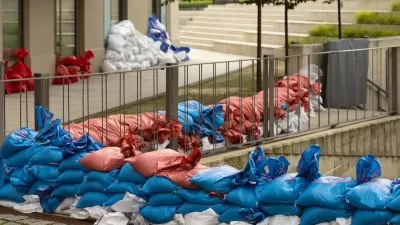In celebration of Water Week in the United States, as well as World Water Day, as celebrated by the United Nations, Brookings has complied a list of ten facts about water policy and infrastructure.

"From the water safety crisis in Flint, Michigan to the near-disaster with the Oroville Dam in California, a string of water-related events have made headlines, and called into question the U.S. focus on keeping critical water systems safe and functioning," according to a post by Alison Burke. So it's fortuitous timing that Water Week has arrived in the United States, and that today is the United Nation's World Water Day.
The post collects the Brookings team's research on the matters of water, so the article opens the floodgates, so to speak, to a lot more reading. Here are the ten facts as listed, with the relevant studies, research, and details available after the jump:
- Water plays a critical role in the economy.
- The federal government only accounts for a small share of total public spending on water infrastructure.
- Geographic and political boundaries can pose challenges to water investment
- The cost of water is on the rise in many cities.
- There's a mismatch between water investment demand and institutional capacity.
- Only a handful of drinking water utilities in the largest cities nationally rank highly in water investment
- The private sector owns most of the nation's dams.
- 69 percent of the nation's dams were built before 1970.
- Climate change and water cycles are closely linked.
- Despite concerns over water safety and infrastructure, Americans have greater access to clean water than most people around the globe.
FULL STORY: 10 facts about water policy and infrastructure in the US

Alabama: Trump Terminates Settlements for Black Communities Harmed By Raw Sewage
Trump deemed the landmark civil rights agreement “illegal DEI and environmental justice policy.”

Planetizen Federal Action Tracker
A weekly monitor of how Trump’s orders and actions are impacting planners and planning in America.

The 120 Year Old Tiny Home Villages That Sheltered San Francisco’s Earthquake Refugees
More than a century ago, San Francisco mobilized to house thousands of residents displaced by the 1906 earthquake. Could their strategy offer a model for the present?

In Both Crashes and Crime, Public Transportation is Far Safer than Driving
Contrary to popular assumptions, public transportation has far lower crash and crime rates than automobile travel. For safer communities, improve and encourage transit travel.

Report: Zoning Reforms Should Complement Nashville’s Ambitious Transit Plan
Without reform, restrictive zoning codes will limit the impact of the city’s planned transit expansion and could exclude some of the residents who depend on transit the most.

Judge Orders Release of Frozen IRA, IIJA Funding
The decision is a victory for environmental groups who charged that freezing funds for critical infrastructure and disaster response programs caused “real and irreparable harm” to communities.
Urban Design for Planners 1: Software Tools
This six-course series explores essential urban design concepts using open source software and equips planners with the tools they need to participate fully in the urban design process.
Planning for Universal Design
Learn the tools for implementing Universal Design in planning regulations.
Clanton & Associates, Inc.
Jessamine County Fiscal Court
Institute for Housing and Urban Development Studies (IHS)
City of Grandview
Harvard GSD Executive Education
Toledo-Lucas County Plan Commissions
Salt Lake City
NYU Wagner Graduate School of Public Service





























